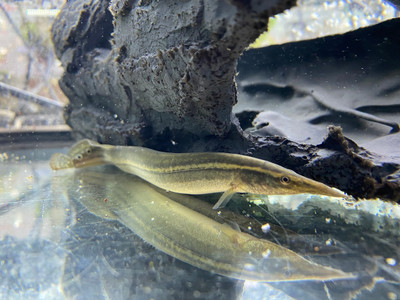Peacock Eel
Posted by Max Gandara on on 14th May 2025
The Mysterious Beauty of the Peacock Eel
When we think of eels, the image that often comes to mind is of slippery, snake-like sea creatures lurking in the deep. But there's one eel that breaks the mold with its stunning looks and peaceful demeanor—the Peacock Eel. Popular in the aquarium trade and native to Southeast Asia, the Peacock Eel (Macrognathus siamensis) is a fascinating freshwater fish that captivates aquarists and nature lovers alike.
Meet the Peacock Eel
Despite its name, the Peacock Eel isn’t a “true” eel. It's actually part of the Spiny Eel family. These fish are called "eels" because of their elongated bodies and undulating swimming motion. The Peacock Eel typically grows to about 8 to 12 inches long and features a slender, dark brown body with a pale yellow underbelly. What makes it truly special are the eye-catching spots near its tail—circular, peacock-like markings that give this eel its common name.
Habitat and Behavior
In the wild, Peacock Eels are found in slow-moving rivers, rice paddies, and marshes throughout Thailand, Laos, Cambodia, and Vietnam. They are bottom dwellers and prefer muddy or sandy substrates where they can burrow and hide. Their reclusive nature means they often stay buried during the day, emerging at night to feed.
Peacock Eels are nocturnal and relatively peaceful, making them suitable tank mates for many non-aggressive fish. However, because they’re shy and easily stressed, they do best in aquariums with plenty of hiding places—like rocks, driftwood, and dense vegetation.
Diet and Care in Captivity
In captivity, Peacock Eels can thrive with the right care. They’re carnivorous and prefer a diet of:
-
Bloodworms
-
Brine shrimp
-
Tubifex worms
-
Small pieces of fish or shrimp
While some may accept high-protein pellets or frozen foods, they usually prefer live or fresh offerings.
Caring for a Peacock Eel requires attention to a few key conditions:
-
Tank size: At least 30 gallons
-
Water temperature: 75–82°F (24–28°C)
-
pH level: 6.5–7.5
-
Substrate: Sand or soft gravel for burrowing
It’s also important to have a secure lid—these eels are notorious escape artists.
Breeding Challenges
Breeding Peacock Eels in home aquariums is extremely rare. Most of the ones available in the pet trade are wild-caught. They require very specific environmental triggers to spawn, which are difficult to replicate in captivity.
Final Thoughts
With its elegant appearance and gentle nature, the Peacock Eel adds an exotic touch to any freshwater aquarium. Though not ideal for beginner fish keepers due to its specific care needs and shy behavior, it's a rewarding species for those willing to provide the right environment.
Whether you're an experienced aquarist looking to add something unique to your tank or simply a fan of extraordinary aquatic life, the Peacock Eel is a creature worth admiring.

